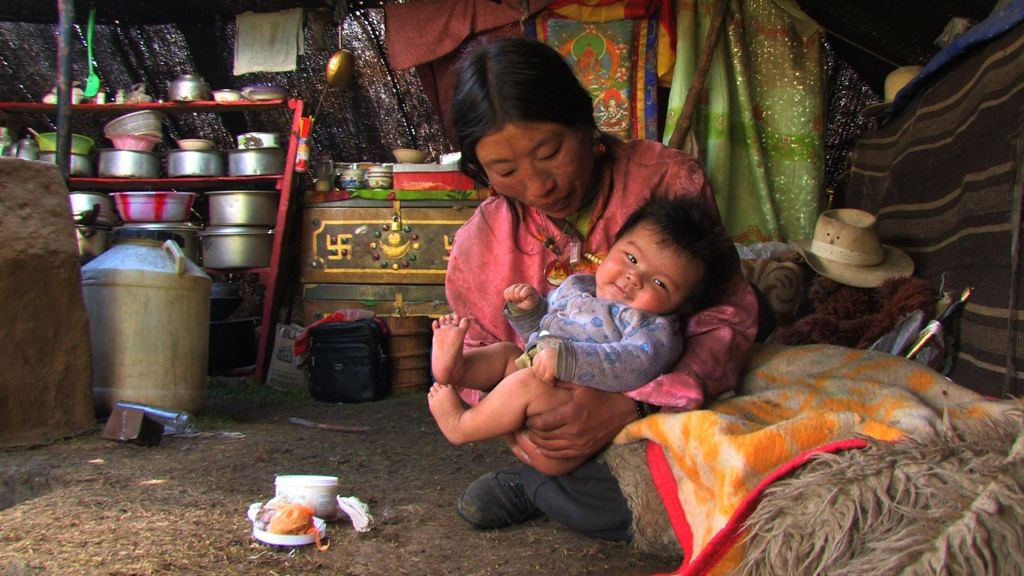
The filmmaking juggernaut of Lynn True, Nelson Walker, and Tsering Perlo dropped by the Independent Lens offices in between trips to Tibet to visit with Locho and Yama, the couple at the heart of their documentary Summer Pasture.
We asked them about making such an intimate film about a culture few Westerners know exists. (We also discovered the astonishing yak photo gallery they have on their site … seriously, go look at some pretty yaks.)
What impact do you hope this film will have?
We were lucky to have such intimate access to the nomad community in Dzachukha, and wanted to make a film that would open a window onto this way of life. Most of all, we hope audiences will feel a sense of personal connection with Locho and Yama, and gain an intimate understanding of the challenges they are facing. Ideally, we’d like Locho and Yama’s experiences to be a starting point for dialogue about the larger issues confronting Tibetan communities.
What led you to make this film?
In 2006 we traveled to eastern Tibet on a project spearheaded by the University of Virginia and the NGO Machik. On this trip, we met Tsering Perlo, a young Tibetan who was in the process of starting his own NGO to encourage filmmaking in Tibet. We became friends, and decided to work together on a film that would be an honest and intimate portrait of the community where Perlo grew up.
What were some of the challenges you faced in making this film?
It was difficult simply getting to the pasture in the first place. After 18 hours of flights to China, the trip involved a 3-day journey by car over mountain roads, and finally 6 hours on horseback. But our greatest challenge was translating the 200 hours of footage we shot. Perlo had helped us communicate when we were filming, but unfortunately we couldn’t work with him during the translation process back in New York. Locho and Yama speak an uncommon dialect of Tibetan, so we had to get much of the footage doubly translated – once from the original dialect into a more common Tibetan dialect, and then again from the more common dialect into English. That whole process took over a year.
How did you gain the trust of the subjects in your film?
Locho is Perlo’s cousin, so trust was never an issue – it was more a matter of Locho and Yama becoming comfortable with the camera, which came from spending a lot of time together and being transparent about our process.
What would you have liked to include in your film that didn’t make the cut?
There was a wonderful scene of Yama feeding her baby yak yogurt for the first time. The baby had yogurt all over her face and in her hair. It was extremely cute, but Yama felt it made her daughter look dirty and asked us not to include it.
Tell us about a scene in the film that especially moved or resonated with you.
When Yama reveals Locho’s infidelities, we were in total shock. She had only mentioned the affair in passing, and then one day when she was washing clothes the whole story just tumbled out. What truly amazed us though, was her response to the situation. Although she and Locho are living the consequences of his actions, Yama has moved forward with such grace and self-assurance.
What has the audience response been so far? Have Yama and Locho seen it, and if so, what did they think?
The response has been really positive, and people often remark how familiar Locho and Yama seem, despite living a world apart. As soon as we had a rough cut of the film, we sent it to Perlo who showed it to Locho and Yama on his laptop. They loved it, and felt it was an accurate portrayal of their lives, which was the greatest compliment we could receive.
The independent film business is a difficult one. What keeps you motivated?
Working as filmmakers has afforded us the extraordinary privilege of getting to know people from all walks of life. It’s these relationships, and a genuine love for the filmmaking process that keeps us going. When you love what you’re doing, the challenges you face become opportunities for creative breakthroughs and personal growth.
Why did you choose to present your film on public television?
Through series like Independent Lens, PBS is one of the few major outlets that truly honors the vision of independent filmmakers. PBS programs reach millions of people, which is a dream come true for us.
What is the question you most get from audiences?
People often wonder what it was like to live in the pasture for three months. We stayed in nylon camping tents and lived a sort of “nomad-light” version of what you see in the film – we rose at dawn, hauled our own water, cooked food over a yak-dung fire, and all our camera batteries were charged on solar panels, though we did bring a small generator to power a laptop and a projector for screening footage.
What didn’t you get done when you were making your film?
Showers. It seems silly, but how we bathed is a common question from Western audiences. We actually did bring a camping shower, but a yak stepped on it and broke it the first day.
What are your three favorite films?
Lynn: I’m a big fan of the Dardenne brothers’ films.
Nelson: It changes with the angle of the sun, but recently I saw The Sun Beaten Path by Sonthar Gyal, and really enjoyed it.
What advice do you have for aspiring filmmakers?
Keep your process open to accidents and detours – they can be great opportunities to make something truly unique and unexpected.
What kinds of comestibles keep you sustained while making your films?
For this film, it was momos, a Tibetan dumpling filled with yak meat, mutton, or vegetables.
